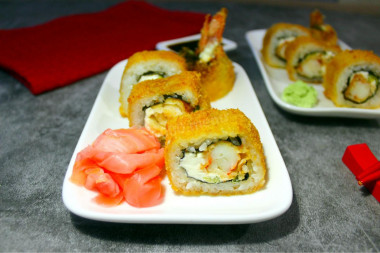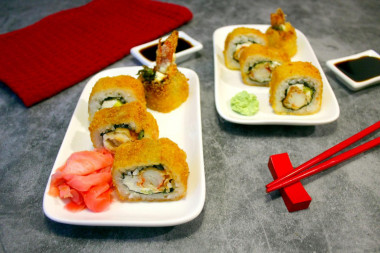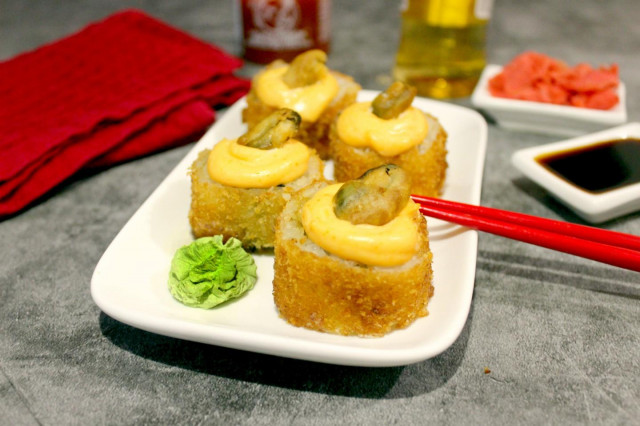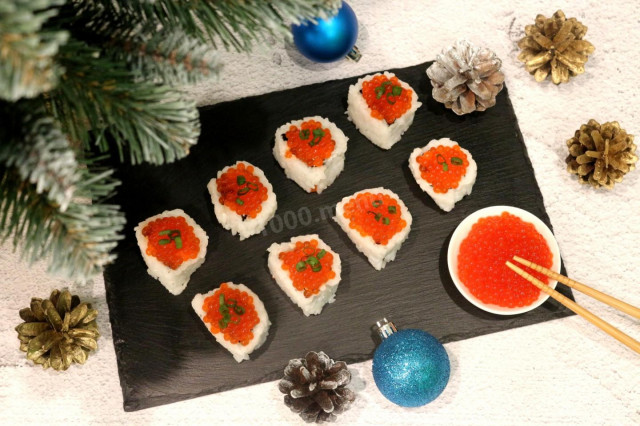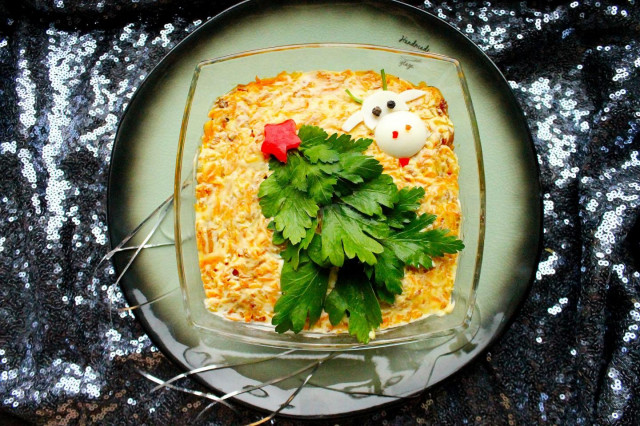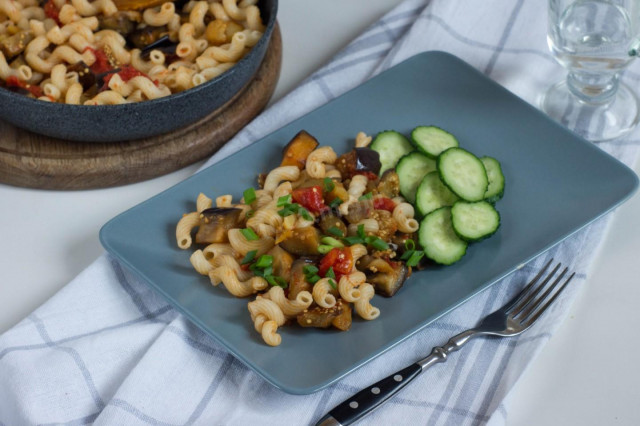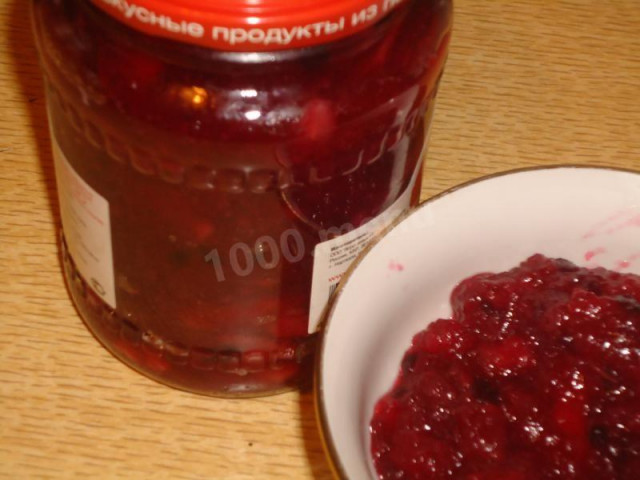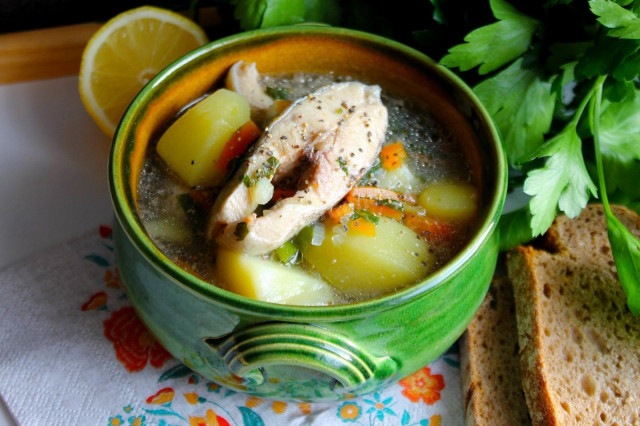Composition / ingredients
Step-by-step cooking
Step 1:
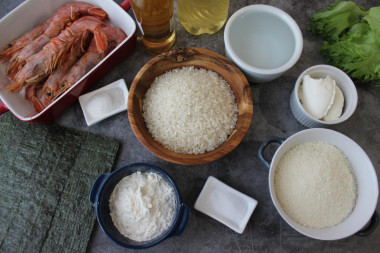
Prepare all the ingredients. Since tempura is a cooking method, the name "ebi" reflects the product that will be prepared in batter, in this case the prefix "ebi" means shrimp. Shrimps should be bought large, you can use royal or tiger. I decided to replace the shrimp with langoustines, since this product is very close to shrimp in its taste.
Step 2:
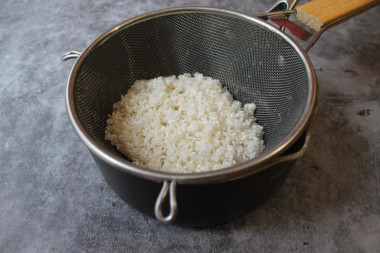
Pour the rice into a bowl, pour cold running water and, in order not to damage the grains, rinse the rice with careful movements, drain the turbid water and pour clean cold running water again. Rice should be washed at least 4 times, the water should become clean and transparent. Discard the washed rice in a colander and leave it for 10 minutes, during which time all the excess liquid will drain.
Step 3:
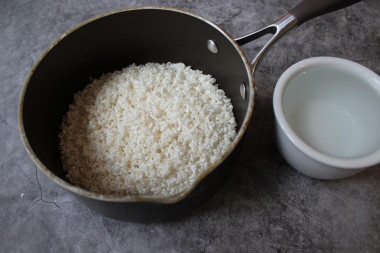
Pour the rice into a saucepan and cover with water, put on fire. It is very important to observe the ratio of rice and water. It should be 1:1. When the water boils, cover the pan with a transparent lid, reduce the heat to low and cook for 15 minutes. During this time, the moisture should completely evaporate. The lid cannot be opened during cooking, therefore, in order to see the cooking process, it is better to use a transparent lid.
Step 4:
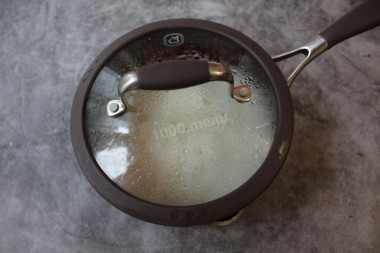
After the specified time, remove the pan with rice from the heat and leave the rice to steam under the closed lid for another 10 minutes. Do not open the lid, the rice should be fully cooked.
Step 5:

At this time, prepare the dressing. Pour rice vinegar into a small ladle (turku), add sugar and salt. Put the ladle on a slow fire and, stirring, dissolve the loose ingredients. As soon as the sugar and salt have dissolved, immediately remove the dressing from the heat. The dressing should never boil, so you can not cook it over high heat.
Step 6:
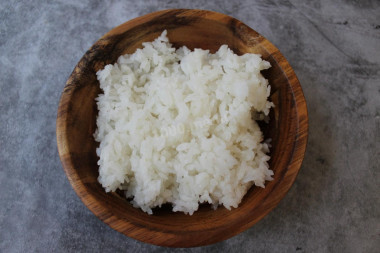
Put the finished rice in a wooden bowl, wiped with a damp towel, so the rice will not stick to the dishes. It is better to use a special tub of hangiri made of cypress, but I don't have one, so I used the one that was. Wooden dishes are used to prevent any interaction with rice vinegar, and also wooden dishes absorb excess moisture of rice when it is stirred.
Step 7:
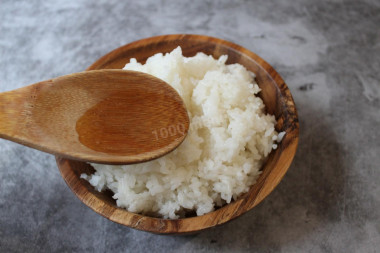
Take a wooden spatula and place it over the rice. Pour the vinegar dressing on the spatula, and it will gently spread over the rice. Break the rice with smooth movements, mix it carefully, trying not to damage the rice grains. Cover with a damp, clean towel and let the rice cool. When the rice cools down, you can start forming sushi and rolls.
Step 8:
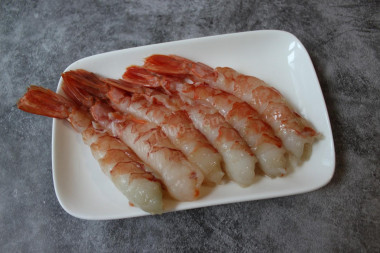
Clean the pre-thawed langoustines: remove the head, remove the shell along with the legs, leaving only the tip of the tail, use sharp scissors or a knife to make an incision along the length of the entire back and carefully remove the intestinal tract. If desired, the tail can also be removed.
Step 9:
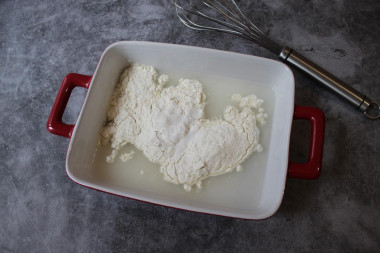
Prepare the batter. Pour cold water into a rectangular mold, add salt and flour. Mix thoroughly with a whisk. The batter should be homogeneous.
Step 10:
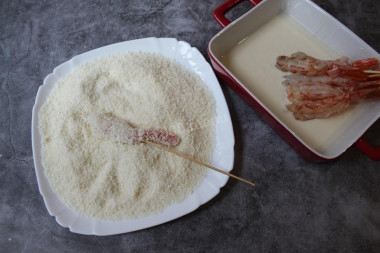
Put the prepared langoustines on wooden skewers, then lower them into the batter, and then into the panko flakes, tightly pressing the langoustines to the flakes so that they are completely covered with breading.
Step 11:
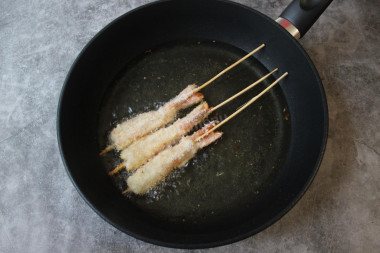
Pour vegetable oil into a wide frying pan and heat it up. The oil needs to be warmed up very well so that the dough sets well. When the oil warms up, lower the panicked langoustines into it. Fry them on both sides until golden brown.
Step 12:
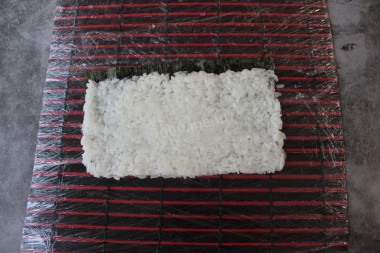
Wrap the mat several times with cling film and lightly lubricate with vegetable oil. Cut the nori sheets in half. On the prepared mat, put the first half of the nori leaf with the glossy side down. In a small container, pour the rice bite and water in a ratio of 1: 3. Moisten your hands in the solution, take 145 grams of boiled rice and level it along the nori, leaving 1 cm free without rice on top, and leaving 1 cm below for the nori repartitions.
Step 13:

Now turn the nori over so that the rice ends up on the mat. At the same time, arrange the nori so that 1 cm of rice free of nori remains on top. Place the filling in the center of the nori leaf: first squeeze out the cream cheese curd through a pastry bag, put the fried langoustines in breadcrumbs next to it, pointing the tails to the outside of the roll, and next to the cream cheese lay out strips of lettuce leaves.
Step 14:
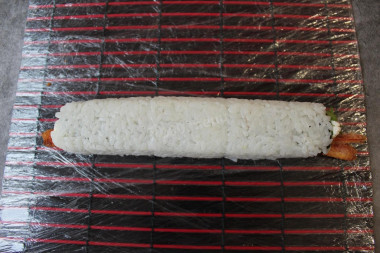
Holding the filling, start gently using the mat to roll up the roll. When the roll is formed, give the roll a round or square shape by pressing it on all sides with a mat.
Step 15:
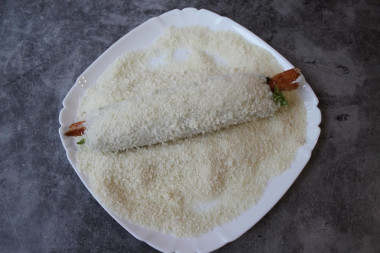
Take 1 wrapped roll and dip its edges into the batter first, and then the roll itself. Also do with the roll crumbling in panko breadcrumbs: first, pan the edges of the roll, and then all the sides.
Step 16:
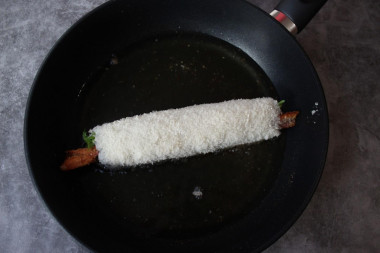
Dip the paned roll into the preheated oil and fry on all sides until golden brown. This process will take several minutes.
Step 17:
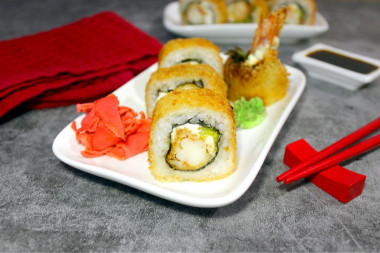
Put the finished roll first on paper towels, let the excess oil go away, and then put it on a board and, wetting the knife in the solution, cut the roll in half. Connect the two halves of the roll and cut in half again. And cut each half again. You should get 8 rolls. The knife must be wetted, so the rice will not stick to the knife, and will not lead to deformation of the rolls.
Use oil with a high smoking temperature for frying! Any oils are useful only until a certain temperature is reached - the point of smoking, at which the oil begins to burn and toxic substances, including carcinogens, are formed in it.
Unrefined oils, with rare exceptions, have a low smoking point. There are a lot of unfiltered organic particles in them, which quickly begin to burn.
Refined oils are more resistant to heating, and their smoking point is higher. If you are going to cook food in the oven, on a frying pan or grill, make sure that you use oil with a high smoking point. The most common of the oils with a high smoking point: refined varieties of sunflower, olive and grape.
Be prepared for the fact that flour may need more or less than indicated in the recipe. Focus not on the amount of flour, but on the desired consistency of the dough. To avoid mistakes, read about flour and its properties!
Caloric content of the products possible in the composition of the dish
- Whole durum wheat flour fortified - 333 kcal/100g
- Whole durum wheat flour, universal - 364 kcal/100g
- Flour krupchatka - 348 kcal/100g
- Flour - 325 kcal/100g
- Granulated sugar - 398 kcal/100g
- Sugar - 398 kcal/100g
- Vegetable oil - 873 kcal/100g
- Lobster (neck meat) - 88 kcal/100g
- Langoustine - 112 kcal/100g
- Nori - 3 kcal/100g
- Salt - 0 kcal/100g
- Water - 0 kcal/100g
- Rice vinegar - 20 kcal/100g
- Breadcrumbs - 347 kcal/100g
- Cottage cheese - 223 kcal/100g
- Round rice - 330 kcal/100g
- Lettuce leaves - 12 kcal/100g


